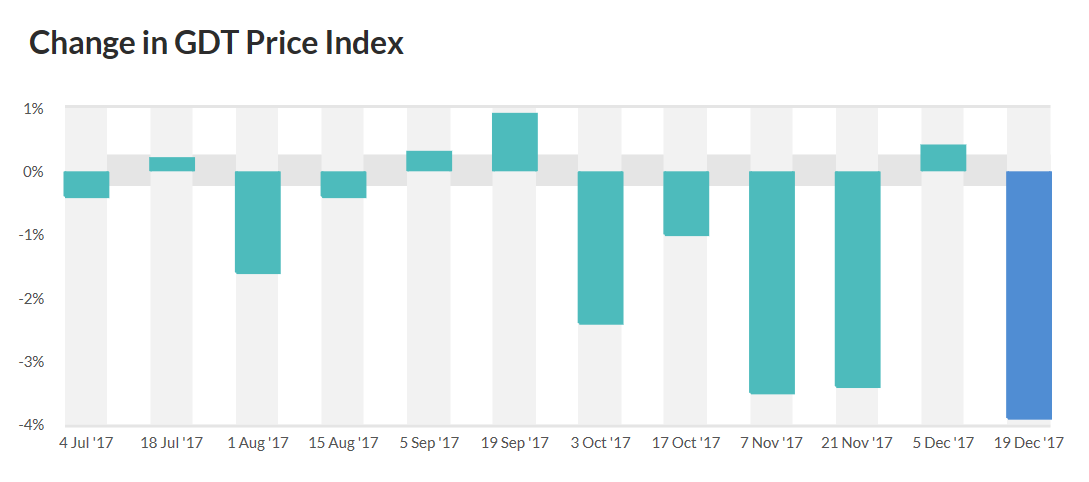The New Zealand Dollar: Compilation of Major Bank Forecasts, Currency Views for 2018

FX Analysts from the world’s top banks give their opinions below on what 2018 might bring for the New Zealand Dollar, otherwise known as the Kiwi.
The Kiwi had a tough year in 2017 going from being one of the strongest currencies in the G10 to one of the weakest as it lost ground against most counterparts due to election risk and falling dairy prices.
The chart below shows the results of the fortnightly global dairy price 'fix' at the global dairy trade auction (GDT), and clearly shows the trend for falling prices.

New Zealand's largest industry is the dairy sector and its largest export is whole dried milk, so the data is a negative drag for the Kiwi as it reduces aggregate demand for the currency from international buyers.
The election has created policy risks for the Kiwi due to the protectionist stance of the new government which has already banned foreign ownership of property, and this looks set to limit incoming flows of foreign investor cash, further lowering demand for the Kiwi.
Headwinds, therefore, are not set to abate but whether they are offset by robust growth, both domestically and globally remains to be seen.
Kathy Lien, Managing Director, BK Asset Management
"New Zealand's economy has been plagued with troubles but as we look forward to the New Year, lower unemployment, the prospect of fiscal stimulus, wage hikes and hotter inflation could prompt the Reserve Bank to start talking about rate hikes.
"Over the next 3 years, the minimum wage is expected to increase 20%. Higher wages should lead to more spending, growth and price pressures that should drive the New Zealand dollar higher."
Viraj Patel, Strategist, ING FX
"While the policy uncertainty of a Labour-NZ coalition has seen the NZD sell-off in recent months, we do expect the currency to stabilise as the dust settles on the new government.
"International investors are likely to remain sceptical in the near-term, not least because of the financial stability risks surrounding the government's policy to ban overseas speculators from buying houses.
"Equally the appointment of a new RBNZ governor and a shift in the dual mandate (full employment as well as price stability) may require a short-term uncertainty premium to be priced into NZ rates and the Kiwi Dollar."

Hans Redeker and James K Lord, Strategists, Morgan Stanley
"High real returns and balance sheet clean-up make EM attractive – the opposite is true of our 'canaries in the coal mine', a club of the DM economies with stretched balance sheets, high leverage, and waning asset quality. Top of the list here include CAD, AUD, and NZD."
"The 'canaries' have seen years of economic growth outpacing income growth. The dominance of US rates in determining global funding costs resulted in local funding costs remaining inappropriately low, given the local needs of these economies, leading to a leverage boom."
"Now, as these economies are running out of balance sheet leverage space, which reduces their growth potential, the US is pushing nominal rates gradually higher, creating further headwinds.
"High real returns in EM and rising US rates mean that the yield advantage offered by these economies relative to G10 counterparts may no longer be sufficient to compensate investors for these growing risks."

Sally M Auld, Economist, J P Morgan
"We continue to expect RBNZ policy to look quite similar under the new mandate as it did under the old, with underperforming activity data and concerns about household vulnerabilities keeping policy quite dovish into 2018.
"We expect 3Q GDP growth in New Zealand to once again underperform the RBNZ’s MPS forecast, at 0.5% q/q (RBNZ: 0.7% q/q).
"The quarterly gain we forecast would see annual growth slip a little to 2.5%oya, underwhelming in the context of 2.4%oya working-age population growth."

Get up to 5% more foreign exchange by using a specialist provider by getting closer to the real market rate and avoid the gaping spreads charged by your bank for international payments. Learn more here.




